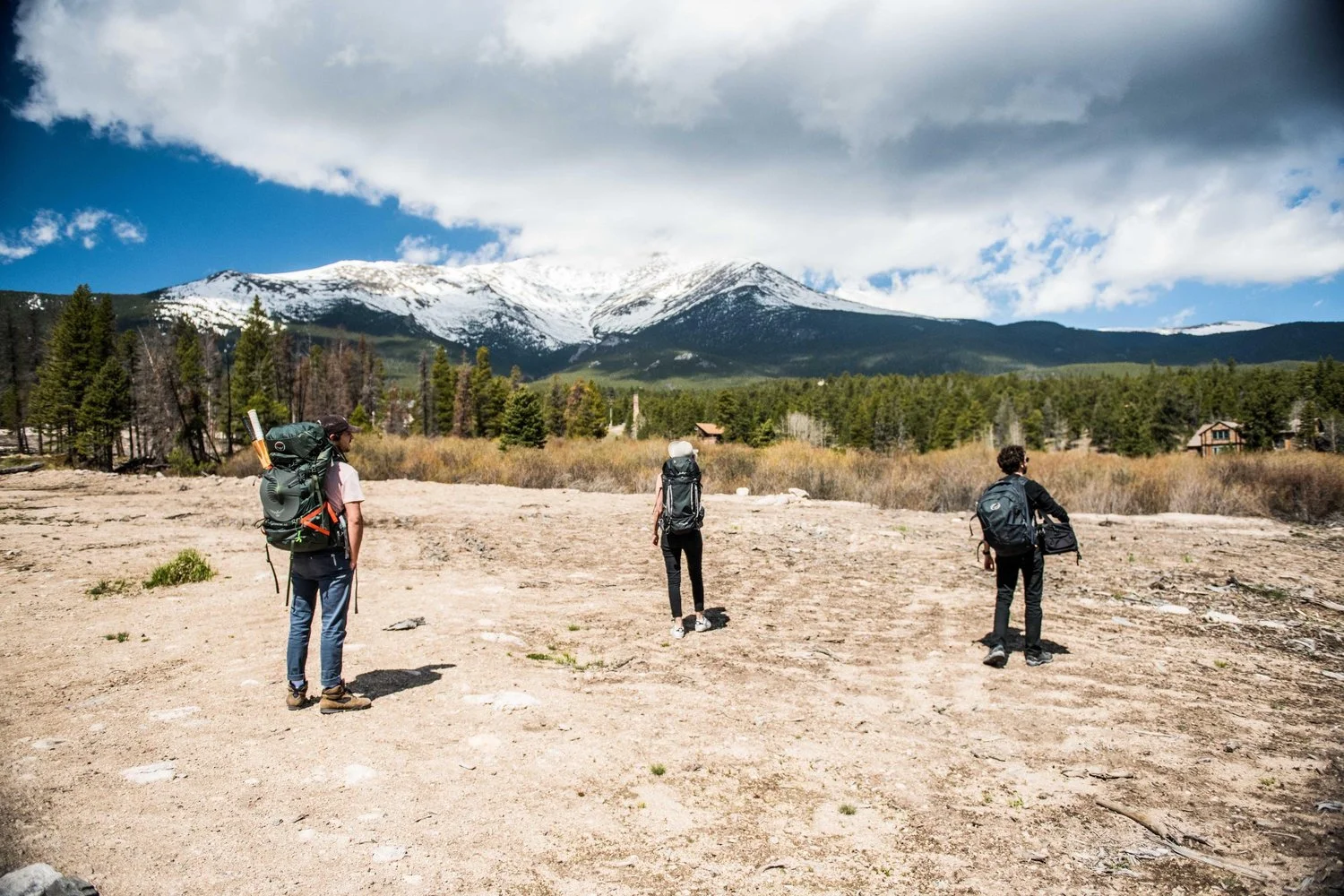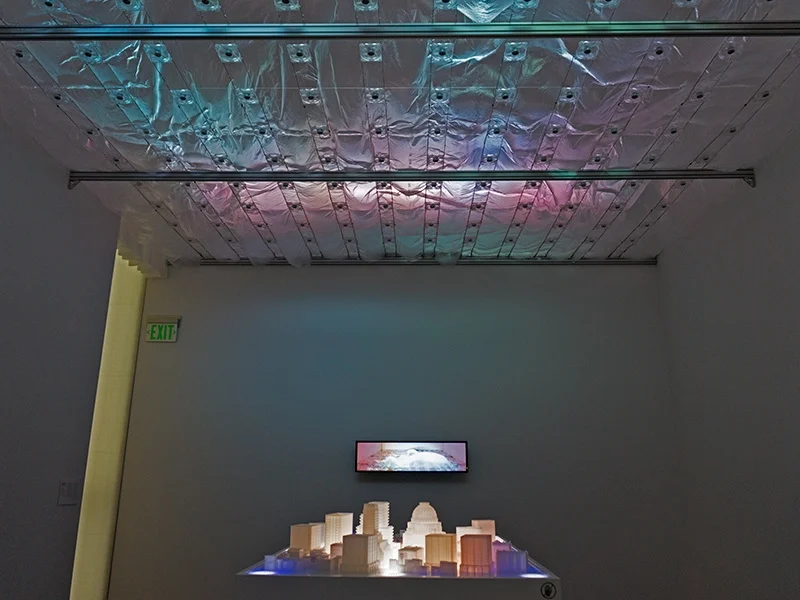Sniff
Karolina Sobecka's Sniff takes the form of a “lowpoly” dog projected in a shop window that interacts with passersby. The dog's behaviors and appearance resemble those of a domestic dog, something like a young German Shepherd, or Collie. These interactions take the form of the dog selecting which person to acknowledge, whether to move toward or away from people, as well as whether to get bored or excited. Additionally the dog takes on friendly or aggressive behaviors depending on audience actions.
Design Playgrounds provides an in-depth description of the amount of software and technology involved in realizing this digital dog:
“People on the sidewalk are monitored by an IR camera in openFrameworks. In oF each individual person is isolated and assigned a unique id for the duration of their interaction. Each persons’ position and gesture information is continually sent to Unity3d via OSC networking protocol. In Unity, an artificial intelligence system representing the dog forms relationships with the individuals.”
Unauthored (undated) “Sniff by Karolina Sobecka and Jim George”
Thus we can see that Sniff consists of two main components, one is a video-tracking system that senses the audience, and the other is a game engine that determines the behaviors of the dog. Though the dog is obviously digital thanks to its “lowpoly” rendering the audience experiences a longing similar to what they have at a local animal shelter. This brings into question why the audience isn't visiting a local animal shelter, interacting with an actual dog in desperate need of attention and care. The dog in Sniff is a symbol for a domestic dog, representing no breed in particular, and it is trapped in a limited space that the audience can interface with but can't actually enter. Though interactions with the “lowpoly” digital dog in Sniff resemble those one may have with an actual dog they are not the same. Instead, with Sniff, as in many interactive artworks, the audience has to figure out what the dog responds to and how it responds. The question arises of who is training who; are the people training the dog/technology, or is the technology training the humans.
Sniff is similar to Sobecka's project Wildlife in its depiction of an animal and exploration of how this animal might appear in an urban environment. In Wildlife digitally animated videos of a tiger are projected perpendicular to a moving car. The velocity of the car determines what video-clip is played; when the car is stopped a video of the tiger standing plays, the tiger trots or walks slowly when the car travels at middle speeds, and when the car drives fast a video of the tiger running plays. While the dog in Sniff is specifically responsive, the tiger in Wildlife has more limited interactive potentials; its location within the city can be directed, as can its speed. The tiger exists in the urban space more like a wild animal, sprinting across buildings, running over people's heads, cutting across crowds. Wildlife relates to the spaces, audience, and architecture of the city in dynamic ways. The cityscape itself becomes an integral component of the artwork. This gives the illusion that the tiger exists in the physical environment. The tiger inhabits an extensive range, something closer to the size of its natural habitat. Wildlife has a strong DIY or even punk-rock undertone. Sobecka didn't ask for permission or deal with bureaucracies to unleash this tiger on the city. Rather, it is an example of city-wide guerrilla projection. Conversely the dog in Sniff is limited to the store-front window which seems appropriate for a digital depiction of a domesticated animal.
Succinctly relating both Wildlife and Sniff, and shining a light onto deeper implications of Sobecka's work, Amanda Gore, writes;
“Karolina uses the city as her medium, combining technology and philosphy[sic] in gritty, urban settings in an attempt to make the world more beautiful and meaningful.”
Gore, Amanda (2006, Nov. 23) Interactive Wildlife Projections
Building on these themes, the ISEA2006 (International Symposium of Electronic Art) has this to say about Sobecka's Wildlife:
“Wild animals in urban context become unautonomous contrivances brought into being by our romanticizing of nature. Extracted from their natural context (and forced out of their habitats by human encroachment), their existence is dependent on and tied to our fancies.”
unauthored (2006, Jun. 12) Wildlife
In San Andreas Deer Cam by Brent Watanabe an invincible deer runs around the environments of the video-game Grand Theft Auto V: San Andreas, a game in which the goal is usually to violently steal cars and shoot people. The deer ends up in a wide variety of situations, ranging from the streets of the city, to an active military base, to the bottom of the ocean. Likewise, the deer might spend an hour on the side of a mountain at the edge of the city, it may run down the freeway (frequently being hit by oncoming traffic), and it may wander the city, by turns frightening bystanders or being attacked by them, amongst other possibilities. The invincible deer acts as the avatar for a nature spirit, or kami, for Grand Theft Auto. The game, which would normally be playable, and in that sense interactive, becomes a kind of remote camera, or “wildlife cam”. In a further deviation from a traditional “wildlife cam” the camera in San Andreas Deer Cam is able follow the deer wherever it might go, a continuous tracking shot. This can be seen as a kind of inversion of the projection of the dog in Sobecka's Sniff.
Sniff, Wildlife, and San Andreas Deer Cam each redefine the relationship between humans, animals, and the urban environment in different ways. It is notably ironic that depictions of wild animals would be made with the same technologies that are responsible for destroying the habitats they would otherwise inhabit. One purpose of cities is to provide us with protection from wilderness. This situation is reversed as more and more it is natural environments that must be protected from encroaching and ever-increasing urban development. It is the same with animals; animals previously feared and hunted are now introduced artificially and digitally as romanticized avatars into our metropolises. Likewise, it is interesting and important to note the potentials for digital animal representations and interactions to either confirm and mimic our usual relationships to wildlife or to bring them to our attention for questioning and contemplation. We are left with troubling questions about what it means for our interactions with animals (wild and domestic) and wilderness to be increasingly digitized. Fortunately, all three of these artworks can point toward a dialogue about these topics.
Karolina Sobecka:
http://file.org.br/artist/karolina-sobecka/
Sniff:
http://www.gravitytrap.com/artwork/sniff
http://www.momentum-women-art-technology.com/sobecka3.htm
http://designplaygrounds.com/deviants/sniff-by-by-karolina-sobecka-jim-george/
Insight into the actual workings of Sniff, including example project, from software designer Jim George:
http://forum.unity3d.com/threads/sniff-public-interactive-dog-installation.30071/
Wildlife:
http://www.gravitytrap.com/artwork/wildlife
http://www.flightphase.com/expanded-media/wildlife
http://pilipinastreetplan.blogspot.com/2008/09/electronic-art-graffiti-wildlife-by.html
http://we-make-money-not-art.com/san_jose_wildli/
http://we-make-money-not-art.com/san_jose_wildli/#.VKxuC8npyzl
Wildlife videos:
https://www.youtube.com/watch?v=CufzjUfINgA
https://www.youtube.com/watch?v=UBaR7XwRfdE
San Andreas Deer Cam
http://sanandreasanimalcams.com/
Additional sources:
http://www.brokencitylab.org/blog/visualizing-pollution-making-nature-move/
Suggested soundtrack =
https://www.youtube.com/watch?v=PVBmogGl5xc
Sniff exhibitions:
Tyneside Cinema
November 14 2013 - January 4 2014
DHUB Barcelona
December 2011 - May 2012
FILE Festival Galeria de Arte do SESI Sao Paulo, Brazil
May 7th - 13th 2010
The Dray Walk Gallery, London
July 27th - August 29th 2010
Creative Thrift Shop Brooklyn, New York
March 31st - April 30th 2010
Beall Center University of California Irvine
January 8th - May 7th 2010
Idea Festival Louisville, Kentucky
Sep. 26th - October 31st 2009
Conflux New York City
Sep. 17th - 20th 2009
petroleum corporations using tigers in their advertisements:
Esso Tiger TV Commercial = https://www.youtube.com/watch?v=qz4SZ3D_Vc4
Exxon Supreme commercial with car/tiger morphing - 1992 =
https://www.youtube.com/watch?v=vZ7RI3Lt0QY
EXXON , Tiger on the road commercial = https://www.youtube.com/watch?v=mK23be25BjQ










